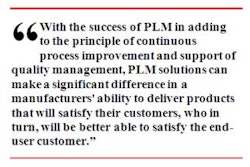
February 24, 2009 — Unless you have taken a vacation from the planet, you can't help but acknowledge that the biggest news in the manufacturing world is layoffs. With over 200,000 layoffs in the manufacturing sector in January alone, it is no wonder that saving and creating jobs is officially priority number one for our new president.
I've seen this movie before.
In every major economic downturn, it seems we come to a point at which every OEM competes for the greatest amount of bad news all at once so they can take their "one-time charge," get the check-off from the investment community and move into hunker-down mode to wait out the storm.
It's time this movie had a new ending.
Great companies realize that the best time to institute meaningful change and gain stronger market position is during a downturn like this. The current surge in the bond market is evidence that companies are making moves. We are seeing capitalist Darwinism at its finest, and I am sure we will continue to see it for the rest of the year.
So how can companies do things differently this time, take advantage of new ideas, retain their most valuable resources — their people — and make gains on their competitors?
As any economist will tell you, productivity is the cornerstone of growth. We are clearly in an age in which access to, and optimal use of, relevant information drives productivity. Jack Welch said, "An organization's ability to learn, and translate that learning into action rapidly, is the ultimate competitive advantage."
This applies now more than ever. Therefore, if you want to make gains during this economic meltdown, you better start digging deeper and smarter into your sources of information for the insights you will need.
This "ultimate competitive advantage" is not adversely affected by credit markets, does not require a bailout to be effective, does not even fall prey to acts of Congress, but it does require people. So, let's talk about how to save jobs through better use of information.
Determining the Ultimate Lowest Total Cost Mix
A great example is provided by a large equipment manufacturer that is pooling together hundreds of people from across the organization who would normally be laid off. They are focusing the efforts of these people on innovative cost reduction initiatives that not only will save enough money to pay their salaries but also will create real changes in the organization — changes that will allow the company to emerge from the recession in a much stronger position.
And what is the key to success for this effort? Better mining and use of their critical product information.
Using a new type of analysis called "competitive banding," they are digging deep into the recesses of their CAD files and financial systems to put together a virtual storehouse of relevant feature information (e.g., height, volume, quantity of drilled holes, weight, material, tolerances, manufacturing requirements, pricing, demand, suppliers, etc.). They are then dedicating the best analytical minds in the organization to new forms of analysis on this information. And the oversight for this project goes all the way up to the CEO.
In competitive banding analysis, manufacturing companies are able to directly tie individual component features to pricing and sourcing information to determine the drivers of competitiveness across all of their products. In doing so, they can effectively determine the best price at which they can acquire each component in their market from the most effective producer. This allows them to rebalance their production and sourcing mix across all their components for the ultimate lowest total cost mix. Insights from competitive banding also relate to the design of these components so manufacturers can design them to be most cost-effectively produced, either internally or externally.
This competitive banding process is being launched using several teams made up of the pooled resources from around the organization. Each team conducts a series of 30 day workshops on their chosen set of components. These workshops identify and isolate inefficiencies in pricing, sourcing and/or design, and lay out corrective actions.
Each workshop leads to enough savings to pay for up to 20 salaries per year. At a large manufacturing company, collectively these workshops can save hundreds of jobs. It is a stimulus package in its own right. At the end of the year, the manufacturer will not only gain massive efficiencies that will better position the company to tackle the market but will also retain more of the talented resources that will fuel its recovery and growth.
It is time that more manufacturers realize the potential in their information and understand that their own people are the key to unlocking it. There are many innovative ways to amass critical information and glean real competitive value from it. Layoffs are not the solution to getting through these tough times; they are part of the problem. Let's all continue to think of ways we can keep talented people employed through creative initiatives that make better use of information.
I've seen this movie before.
In every major economic downturn, it seems we come to a point at which every OEM competes for the greatest amount of bad news all at once so they can take their "one-time charge," get the check-off from the investment community and move into hunker-down mode to wait out the storm.
It's time this movie had a new ending.
Great companies realize that the best time to institute meaningful change and gain stronger market position is during a downturn like this. The current surge in the bond market is evidence that companies are making moves. We are seeing capitalist Darwinism at its finest, and I am sure we will continue to see it for the rest of the year.
So how can companies do things differently this time, take advantage of new ideas, retain their most valuable resources — their people — and make gains on their competitors?
As any economist will tell you, productivity is the cornerstone of growth. We are clearly in an age in which access to, and optimal use of, relevant information drives productivity. Jack Welch said, "An organization's ability to learn, and translate that learning into action rapidly, is the ultimate competitive advantage."
This applies now more than ever. Therefore, if you want to make gains during this economic meltdown, you better start digging deeper and smarter into your sources of information for the insights you will need.
This "ultimate competitive advantage" is not adversely affected by credit markets, does not require a bailout to be effective, does not even fall prey to acts of Congress, but it does require people. So, let's talk about how to save jobs through better use of information.
Determining the Ultimate Lowest Total Cost Mix
A great example is provided by a large equipment manufacturer that is pooling together hundreds of people from across the organization who would normally be laid off. They are focusing the efforts of these people on innovative cost reduction initiatives that not only will save enough money to pay their salaries but also will create real changes in the organization — changes that will allow the company to emerge from the recession in a much stronger position.
And what is the key to success for this effort? Better mining and use of their critical product information.
Using a new type of analysis called "competitive banding," they are digging deep into the recesses of their CAD files and financial systems to put together a virtual storehouse of relevant feature information (e.g., height, volume, quantity of drilled holes, weight, material, tolerances, manufacturing requirements, pricing, demand, suppliers, etc.). They are then dedicating the best analytical minds in the organization to new forms of analysis on this information. And the oversight for this project goes all the way up to the CEO.
In competitive banding analysis, manufacturing companies are able to directly tie individual component features to pricing and sourcing information to determine the drivers of competitiveness across all of their products. In doing so, they can effectively determine the best price at which they can acquire each component in their market from the most effective producer. This allows them to rebalance their production and sourcing mix across all their components for the ultimate lowest total cost mix. Insights from competitive banding also relate to the design of these components so manufacturers can design them to be most cost-effectively produced, either internally or externally.
This competitive banding process is being launched using several teams made up of the pooled resources from around the organization. Each team conducts a series of 30 day workshops on their chosen set of components. These workshops identify and isolate inefficiencies in pricing, sourcing and/or design, and lay out corrective actions.
Each workshop leads to enough savings to pay for up to 20 salaries per year. At a large manufacturing company, collectively these workshops can save hundreds of jobs. It is a stimulus package in its own right. At the end of the year, the manufacturer will not only gain massive efficiencies that will better position the company to tackle the market but will also retain more of the talented resources that will fuel its recovery and growth.
It is time that more manufacturers realize the potential in their information and understand that their own people are the key to unlocking it. There are many innovative ways to amass critical information and glean real competitive value from it. Layoffs are not the solution to getting through these tough times; they are part of the problem. Let's all continue to think of ways we can keep talented people employed through creative initiatives that make better use of information.












